A list of Native American picture books for children depicting a variety of Indigenous cultures in the present-day.
This list spotlights picture books by Native American and First Nation creators. You can use the titles on this list during Native American History Month, but I encourage you to read these books all year long!

It's fair to say, that growing up a white girl in the 1970s and 80s, my exposure to Native American representation in children's books was woefully inadequate. I am determined my own kids will be better educated, and will understand from the start that Native peoples are part of a vibrant, present-day community. (I also recognize that I am still learning, too.)
Native Americans in Children's Literature
Making sure our children's libraries are diverse is crucial, but unfortunately, not all children are represented fairly, accurately, or abundantly in picture books. Historically, Native Americans and Indigenous Peoples have been not only underrepresented in children's books, but frequently that representation is racist, either through stereotyping (including so-called "positive" images like the "noble savage") or by obvious negative imagery.
When choosing and reading books with Indigenous characters, this list of Do's and Don'ts about Teaching Respect for Native Americans by Doris Seale and Beverly Slapin is an extremely helpful resource for parents and educators. It's appalling to realize that almost every "don't" was a reality in my own educational experience.
Please note that whereas in what is now the present day United States we use the general terms "Native American," "American Indian" or "Native Alaskan," these terms are not used in present day Canada, which uses "First Nations" or "Indigenous People."
I encourage you, whenever possible, to use specific Nation names, such as "Diné," "Cree," or "Lenape." On this list, I've identified authors and illustrators by their tribal/nation identity. Please let me know if I've made any errors.
Table of contents
Note: this list contains Amazon and Bookshop affiliate links. Purchases made through these links may earn a commission for this blog. Bookshop also supports independent bookstores. See my giant Native American book list at Bookshop.
Books for Babies and Toddlers
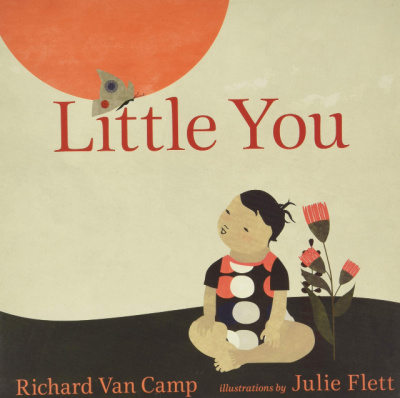
Little You by Richard Van Camp (Tłı̨chǫ Dene), illustrated by Julie Flett (Cree/Métis)
I absolutely love this adorable board book. Little You is a tender, rhyming love story from mom and dad to their baby. Illustrator Julie Flett uses autumnal colors to depict the family as the baby grows. Simply marvelous.
Also by Richard Van Camp:
- Kiss by Kiss / ocêhtowina: A Counting Book for Families
- We Sang You Home
- Welcome Song for Baby: A Lullaby for Newborns

My Heart Fills with Happiness by Monique Gray Smith (Cree), illustrated by Julie Flett (Cree/Métis)
This is a super sweet and wonderful board book perfect for any age child. The text and joyful, colorful illustrations celebrate finding happiness in everyday events.
Also by Monique Gray Smith:
- When We Are Kind
- You Hold Me Up
- I Hope
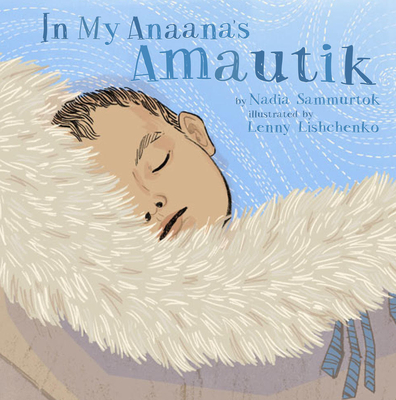
In My Anaana's Amautik by Nadia Sammurtok (Inuit), illustrated by Lenny Lishchenko
An inuit toddler (the child's gender is ambiguous) narrates the wonderful and utterly comforting experience of being wrapped up in the coziness of an amautik. Their narration describes the experience using sensory language like how it feels and smells. A soft sprinkling of Inuktitut words throughout the text enhances, rather than detracts, from the experience (glossary included) and I'm guess your child will never think of the northern terrain as frozen and barren again. Ages 2 and up.
Also by Nadia Sammurtok:
- The Owl and the Two Rabbits
- To My Panik: To My Daughter
Ages 3 and up
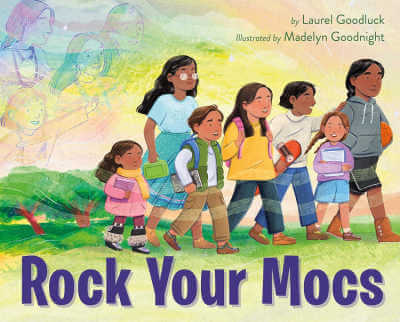
Rock Your Mocs by Laurel Goodluck (Mandan, Hidatsa & Tsimshian Nations), illustrated by Madelyn Goodnight (Chickasaw)
This joyful picture book is a tribute to Rock Your Mocs Day, celebrated on November 15th. Children from different Indigenous communities (twelve are named individually), engaged in a variety of activities, wear their moccasins with pride. The text references the history and significance of the eponymous footwear, while also confirming its importance in the present day. Includes a pronunciation guide and an informative end note. Ages 4 and up.
Also by Laurel Goodluck:
- Too Much: My Great Big Native Family
- Forever Cousins
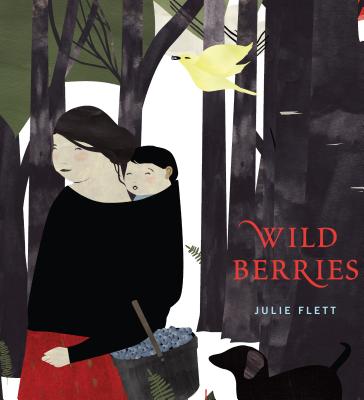
Wild Berries by Julie Flett (Cree/Métis)
A boy and his grandmother collect blueberries in the wood. Along the way they observe wildlife from the ants to the elk to the birds. The overall feeling is one of calm mindfulness and the illustrations' beautiful simplicity adds to that feeling. The spare text is in English, but some of the words are accompanied by their Cree equivalent. A glossary and pronunciation guide is included. Ages 3 and up.
Also written by Julie Flett:
- Black Bear Red Fox: Colours in Cree
- Birdsong
- We All Play: kimêtawânaw
- We All Count: A Book of Cree Numbers

Berry Song by Michaela Goade (Tlingit)
A child and her Tlingit grandmother share the experience of gathering berries while singing a harvest song. They reflect on the beauty of the surrounding nature, the activity back at home while preparing the berries in the kitchen, and the changing of the seasons. Ages 4 and up.
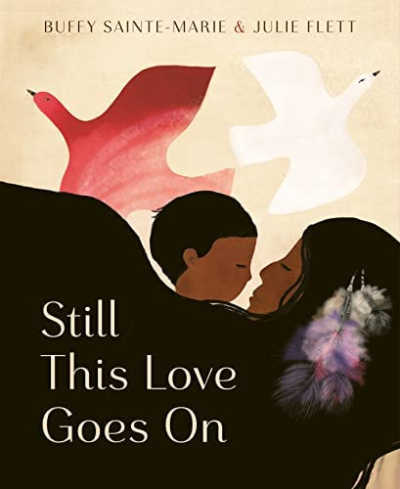
Still this Love Goes On by Buffy Sainte-Marie (Cree), illustrated by Julie Flett (Cree/Métis)
The calming text of this marvelous book is based on lyrics by Cree singer and songwriter Buffy Sainte-Marie. Julie Flett's illustrations are the perfect match. Each double page spread offers soaring vistas or scenes of harmonious relationships (or both!). The narrator is a child who expresses wonder at the natural world around them, periodically punctuated with the phrase, "and still this love goes on." Heartwarming. All ages.
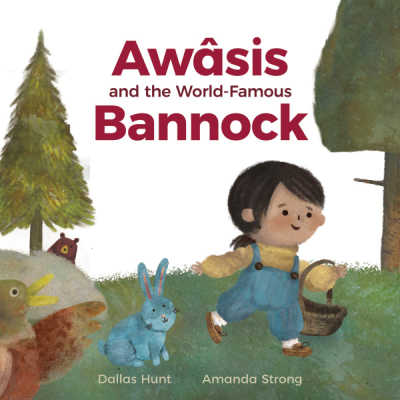
Awâsis and the World-Famous Bannock by Dallas Hunt (Wapsewsipi), illustrated by Amanda Strong
This absolutely delightful story has a folktale/fairy tale quality to it. Awâsis accidentally loses her grandmother Kôhkum's world-famous bannock and looks to her forest friends for help. Each of the woodland creatures assists her in gathering together the needed ingredients so Kôhkum, Awâsis and the animals can mix up a new batch. This book makes a wonderful read aloud. Cree words are seamlessly integrated into the story. Ages 3 and up.
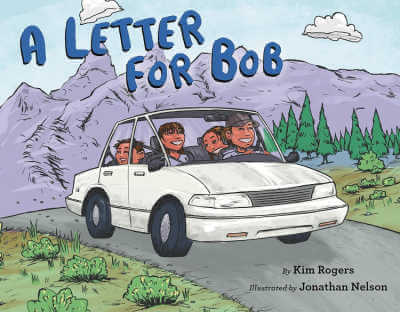
A Letter for Bob by Kim Rogers (Wichita), illustrated by Jonathan Nelson (Diné)
Bob is the car that took Katie's family to powwows, on trips to visit Aka:h (grandma), on family vacations and everyday places like school and the library. Bob even protected the family in an accident. But in this sweet and funny book it's now time to bid farewell and thank you to Bob for all the memories and care. Charming. Ages 4 and up.
Also by Kim Rogers (Wichita):
- I Am Osage: How Clarence Tinker Became the First Native American Major General
- Just Like Grandma
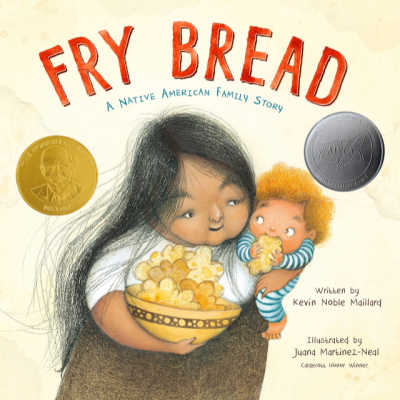
Fry Bread by Kevin Noble Maillard (Mekusukey Seminole), illustrated by Juana Martinez-Neal
This utterly marvelous and cheerful book is a celebration of fry bread and its place in Native American family culture. The bouncy verse tells the history of fry bread, its importance in Native American life, how it's eaten, enjoyed and what it represents. An end note explains the context further. Highly recommended! Ages 3 and up.
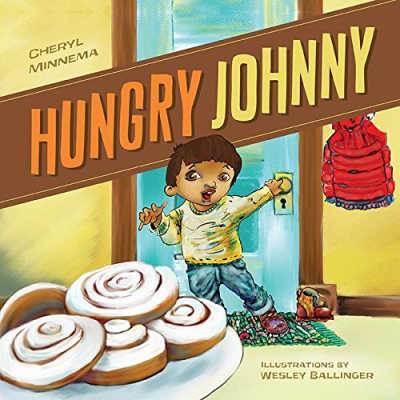
Hungry Johnny by Cheryl Minnema (Mille Lacs Band of Ojibwe), illustrated by Wesley Ballinger (Mille Lacs Band of Ojibwe)
Here's a fun book to read that teaches kids that it is possible to be courteous and respectful, even when you are so very, very hungry for yummy treats! Before they drive over to the community center for a meal, Johnny watches his grandma cook delicious food in her kitchen. At the community meal, all the kids know that first they must listen to the Ojibwe prayer, then they must wait for the elders to eat, and only then can they help themselves. Johnny worries that there won't be any food left, but his grandmother helps him wait it out. Ages 3 and up.

Remember by Joy Harjo (Mvskoke), illustrated by Michaela Goade (Tlingit)
Lush, dreamlike illustrations by Caldecott medalist, Michaela Goade, accompany the text of U.S. Poet Laureate Joy Harjo’s poem. Harjo's words take readers on a journey beginning with birth under the sky, reminding us to connect with our world, the environment and our family. Beautiful. Ages 4 and up.
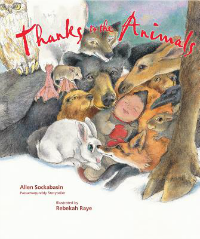
Thanks to the Animals by Allen Sockabasin (Passamaquoddy)
During his Passamaquoddy family's move to their winter home in what is now rural Maine, Little Zoo Sap falls off the sled. The local animals care for the frightened boy and keep him warm. When his father, Joo Tum, notices his son is missing, he determinedly searches for the boy. When he finds Little Zoo Sap he takes the time to thank each animal for their protection. That was perhaps my favorite part—that the father didn't just pick up his kid and go—he was mindful and grateful to the animals! Ages 3 and up.

Keepunumuk: Weeâchumun's Thanksgiving Story by Danielle Greendeer (Mashpee Wampanoag), Anthony Perry (Chickasaw), and Alexis Bunten (Yu'pik and Unangan), illustrated by Garry Meeches (Anishinaabe)
Even though this is a non-present day book, I think it's important given the way American Indians are always associated with Thanksgiving in popular culture. A grandmother tells her two Wampanoag ("People of the First Light") grandchildren the story of Thanksgiving. Weeâchumun (the Wampanoag word for "corn," here represented as a translucent woman) is worried because she is afraid that she will not last another year. Despite a caution to be wary of the new comers, Weeâchumun asks the Wampanoag people to help the Pilgrims survive the winter by helping them plant the three sisters of corn, beans and squash. This is an important retelling of the Thanksgiving story that places the Wampanoag, and not the Pilgrims at the center of the narrative. The text includes notes, glossary, and a pronunciation guide. The book's official website has further resources. Ages 3 and up.

Kisimi Taimaippaktut Angirrarijarani / Only in My Hometown by Angnakuluk Friesen (Nunavut Inuit), illustrated by Ippiksaut Friesen (Inuit)
A young girl describes life in her Inuit hometown, Nunavut. She describes daily activities, as well as the coming of the northern lights in the dark nights. Readers will be able to feel the affection the narrator has for her home, and reflect on what makes their own hometowns special, too. The text is written in both English and Inuktitut. The Inuktitut text is written out in both syllabics and Roman characters. Ages 4 and up.
Ages 5 and up
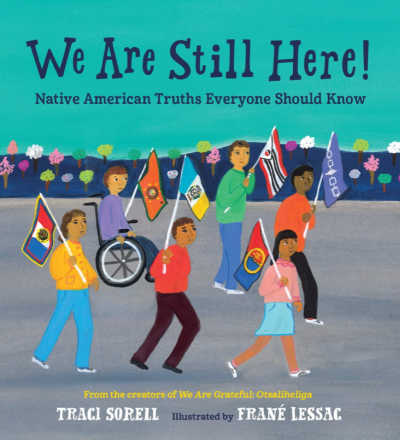
We Are Still Here!: Native American Truths Everyone Should Know by Traci Sorell (Cherokee), illustrated by Frané Lessac
This is a great follow up book to Sorell and Lessac's marvelous We Are Grateful: Otsaliheliga (read it first, if you haven't already! –Ages 4 and up). The text is structured around 12 Native American students sharing presentations about the past, present and future of Native lives for Indigenous Peoples' Day. The students' presentations cover a wide range of subjects from how the US government treated the indigenous population, to environmental, enrollment and language concerns. As the book continues, we learn about the resiliences of Native citizens and their dedication to protect their heritage and build strong economies and institutions. Includes glossary, timeline and more information in end notes. Ages 7 and up.
Also by Traci Sorell:
- We Are Grateful: Otsaliheliga
- At the Mountain's Base
- Classified: The Secret Career of Mary Golda Ross, Cherokee Aerospace Engineer
- Contenders: Two Native Baseball Players, One World Series
- Powwow Day
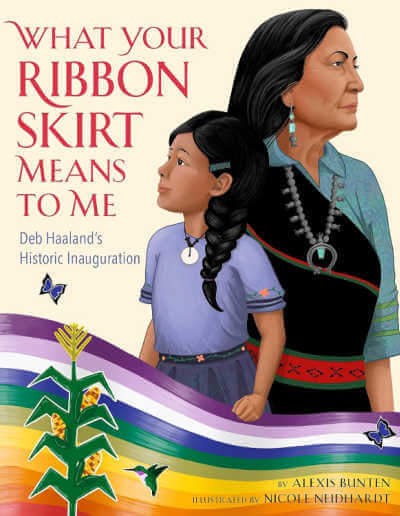
What Your Ribbon Skirt Means to Me by Alexis Bunten (Yu'pik and Unangan), illustrated by Nicole Neidhardt (Diné)
For her inauguration as United States Secretary of the Interior, Deb Haaland wore a traditional ribbon skirt, generating interest in the ceremonial garment. This picture book pays homage to the ribbon skirt and explains its significance and connection to Indigenous womanhood and strength through the story of Pia, who crafts her own skirt while watching Haaland on television. Ages 5 and up.
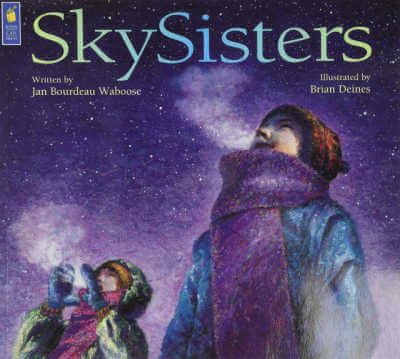
SkySisters by Jan Bourdeau Waboose (Nishnawbe Ojibway), illustrated by Brian Deines
Two Ojibway sisters bundle up and head outside where they observe and appreciate the winter nighttime landscape. As they travel across the snow, they take delight in their footprints, the taste of icicles and the animals they see. As the wind rises and they dance and make snow angels, they are finally rewarded by the colorful showing of the SkySpirits. Wonderful, a must read. Ages 5 and up.

Jingle Dancer by Cynthia Leitich Smith (Muscogee Creek), illustrated by Ying-Hwa Hu and Cornelius Van Wright
Jenna loves to practice her dance steps as she watches videos of her grandmother dancing and listens to the clinking sound of the jingles. She looks forward to finally being able to join in the jingle dance at the powwow but worries that she won't have just the right number of jingles for her skirt. This is a heartwarming story that celebrates family and tradition. ages 5 and up.
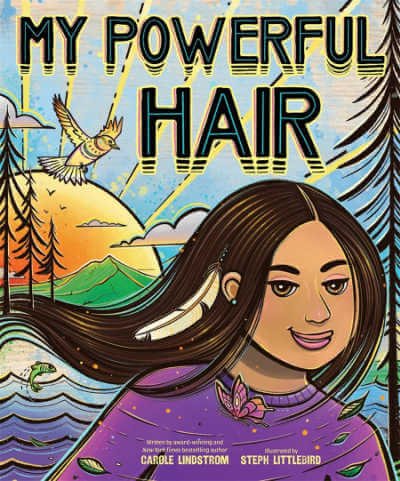
My Powerful Hair by Carole Lindstrom (Turtle Mountain Band of Ojibwe), illustrated by Steph Littlebird (Confederated Tribes of Grand Ronde)
An Indigenous girl narrates her experience waiting for her hair to grow long. She describes how her mother and grandmother were denied long hair for different reasons. However, the narrator knows that hair is a source of power, memories, connection and strength for Native peoples. The woodcut illustrations are marvelous. Back matter gives more information on the importance of hair in Indigenous cultures and the history behind White people's attempt to erase Native culture by cutting their hair. Ages 5 and up.
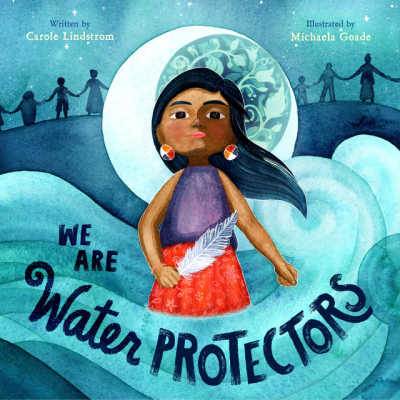
We Are Water Protectors by Carole Lindstrom (Turtle Mountain Band of Ojibwe), illustrated by Michaela Goade (Tlingit)
A girl describes an Anishinaabe prophecy of a black snake terrorizing the land. The black snake is the oil pipeline that threatens the community and the life-giving natural resources of land, water, and animals. Her call to action emphasizes the importance of standing up for those that do not have a voice, protecting the vulnerable and working together. Goade's gorgeous illustrations feature symbolism from her culture. Ages 5 and up.
Also by Carole Lindstrom:
- Autumn Peltier, Water Warrior
- Cuthbert Grant: Leader of the Métis People
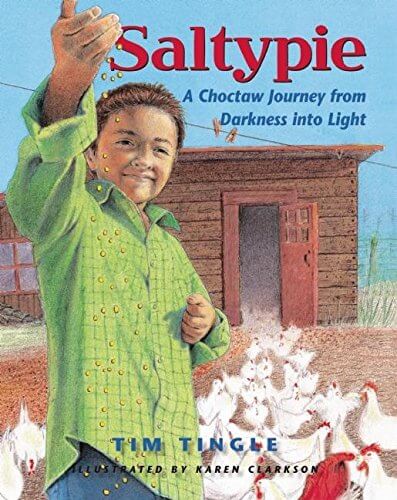
Saltypie: A Choctaw Journey from Darkness into Light by Tim Tingle (Choctaw), illustrated by Karen Clarkson (Choctaw)
This picture book is based on the author's experience moving from Oklahoma to Pasadena, Texas. Looking backward, the narrator describes his experience when he was six and learned his grandmother was blind. I love the intergenerational story of a close, warm family, as well as the narrator's description of Choctaw life and the explicit acknowledgement in the storytelling of the realities of Indigenous life in contrast to stereotyping. Plus, the origin of the term "saltypie" is wonderful! Ages 5 and up.

Stolen Words by Melanie Florence (Cree), illustrated by Gabrielle Grimard
I got a little teary eyed when reading this book. (That happens to me more often than you think!) A happy young girl walks with her grandfather and asks him if he can tell her the Cree word for "grandfather." Her grandfather becomes sad and tells her he does not know and then tells her about how, when he was a boy, he was taken to a white school where he wasn't allowed to speak his Cree language. The next day the girl brings home an Introduction to Cree book and presents it to her grandfather who starts to remember the stolen words. Ages 5 and up.
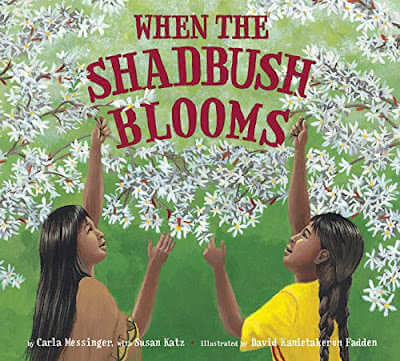
When the Shadbush Blooms by Carla Messinger (Turtle Clan Lenape) and Susan Katz, illustrated by David Kanietakeron Fadden (Akwesasne Mohawk)
Find it: Your Library | Amazon
A Lenape girl reflects on how her experiences throughout the seasons were mirrored generations ago by her ancestors. This mirroring is reflected in the illustrations. For example, a group of traditional Lenape fish from their canoes is on one page, and a contemporary Lenape family catches fish with modern fishing poles on the next. What I love about this book is that it doesn't confine the Lenape traditions to either the past or the present, but demonstrates that they can exist in both. Ages 6 and up.
More Resources
Here are some resources for further reading:
- American Indians in Children's Literature
- Teaching Young Children about Native Americans - Illinois Learning Project
- Native American Literature in Your Classroom - National Museum of the American Indian


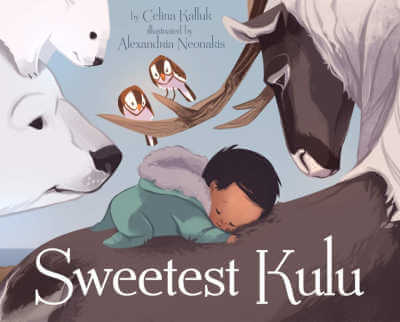

Leinana Two Moons says
My husband is Native American, we have 2 small ones, and I love this list. I would also add "Mama Do You Love Me?" by Barbara M. Joosse
Erica says
I love that book! Great suggestion.
Nicole says
Also 'Hungry Johnny"
https://www.amazon.com/Hungry-Johnny-Cheryl-Kay-Minnema/dp/0873519264
Published by MN Historical Society Press
Erica says
Thanks for the recommendation!
Karen Lucas says
I always appreciate your lists and I want to make sure you have access to Dr. Debbie Reese's recommendations and book reviews. Dr. Reese has some really great advice in terms of looking at looking at Native representation in children's books. Her blog is called American Indians in Children's Literature. It has a search feature that allows readers to find reviews of particular books. She also has a listing of Native authors currently publishing.
Thanks for your work, Karen
Erica says
Thanks Karen! I do read Dr. Reese's blog. It's a great resource.